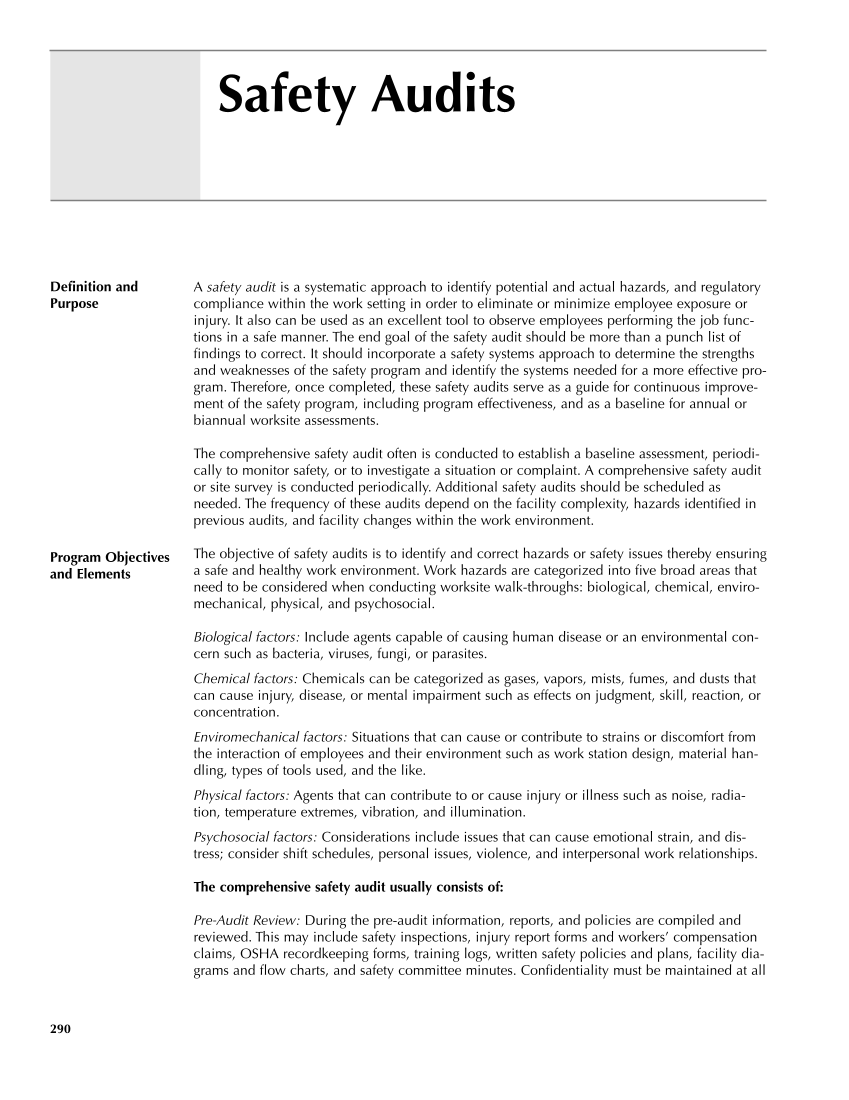290 A safety audit is a systematic approach to identify potential and actual hazards, and regulatory compliance within the work setting in order to eliminate or minimize employee exposure or injury. It also can be used as an excellent tool to observe employees performing the job func- tions in a safe manner. The end goal of the safety audit should be more than a punch list of findings to correct. It should incorporate a safety systems approach to determine the strengths and weaknesses of the safety program and identify the systems needed for a more effective pro- gram. Therefore, once completed, these safety audits serve as a guide for continuous improve- ment of the safety program, including program effectiveness, and as a baseline for annual or biannual worksite assessments. The comprehensive safety audit often is conducted to establish a baseline assessment, periodi- cally to monitor safety, or to investigate a situation or complaint. A comprehensive safety audit or site survey is conducted periodically. Additional safety audits should be scheduled as needed. The frequency of these audits depend on the facility complexity, hazards identified in previous audits, and facility changes within the work environment. The objective of safety audits is to identify and correct hazards or safety issues thereby ensuring a safe and healthy work environment. Work hazards are categorized into five broad areas that need to be considered when conducting worksite walk-throughs: biological, chemical, enviro- mechanical, physical, and psychosocial. Biological factors: Include agents capable of causing human disease or an environmental con- cern such as bacteria, viruses, fungi, or parasites. Chemical factors: Chemicals can be categorized as gases, vapors, mists, fumes, and dusts that can cause injury, disease, or mental impairment such as effects on judgment, skill, reaction, or concentration. Enviromechanical factors: Situations that can cause or contribute to strains or discomfort from the interaction of employees and their environment such as work station design, material han- dling, types of tools used, and the like. Physical factors: Agents that can contribute to or cause injury or illness such as noise, radia- tion, temperature extremes, vibration, and illumination. Psychosocial factors: Considerations include issues that can cause emotional strain, and dis- tress consider shift schedules, personal issues, violence, and interpersonal work relationships. The comprehensive safety audit usually consists of: Pre-Audit Review: During the pre-audit information, reports, and policies are compiled and reviewed. This may include safety inspections, injury report forms and workers’ compensation claims, OSHA recordkeeping forms, training logs, written safety policies and plans, facility dia- grams and flow charts, and safety committee minutes. Confidentiality must be maintained at all Safety Audits Definition and Purpose Program Objectives and Elements
Purchased from OEM Press by (ge corporate access). (C) 2013 OEM Health Information, Inc. All rights reserved.












































































































































































































































































































































































































































